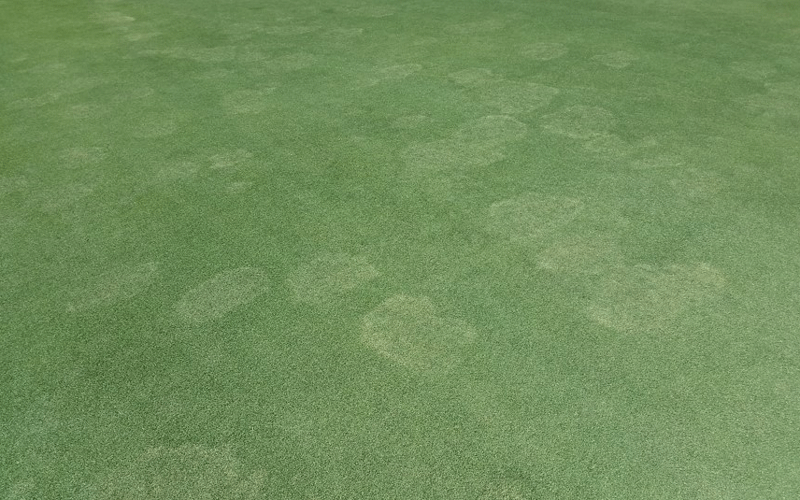Take-All Root Rot in Warm-Season Greens
Take all root rot (TARR) is just around the corner, so now is the time to plan and initiate fungicide programs for TARR (caused by Gaeumannomyces graminis var. graminis and at least 4 others) in warm-season greens. Take-all root rot can be a major problem starting in midsummer and can persist into the spring months.
- Conducive conditions
- Once thought of as a fall disease, relatively recent research at North Carolina State University suggests optimum growth of TARR fungi is between soil temperatures of 68-86oF at 2”
- However, TARR can be active throughout the summer and fall during prolonged cloudy and wet weather, and symptoms are enhanced by additional stresses such as lower mowing height, low fertilization, aggressive cultivation, or over regulation from PGRs
- Long term cultural practices to minimize TARR:
- Maximize drainage – install new drain lines or improve surface drainage where practical
- Employ aerification and sand topdressing to limit organic matter accumulation and improve water movement through the profile
- Increase mowing height and consider rolling to maintain green speed
- Maintain soil pH between 5.5 and 6.0 by eliminating lime and nitrate forms of nitrogen
- Applications of manganese sulfate can reduce take-all root rot
- Use a 1:1 balance of nitrogen (N) with potassium (K) and switch to foliar fertilizer if roots become damaged or poorly functioning
- Control nematodes which can enhance damage from TARR
- Fungicide program for TARR
- Traditionally, the fungicide applications targeting TARR were initiated in the fall when soil temperatures dropped below 65°F (2” depth)
- However, given the recent results from NCSU mentioned above, current recommendations for fungicide control of TARR have applications starting earlier in the summer when soil temperatures fall below 86oF in mid-to-late summer
- Furthermore, we know from other soilborne diseases like fairy ring, summer patch, root Pythium, etc., that early applications when the pathogens first become active are highly effective at minimizing damage later in the season
- NCSU also reports that the multiple different pathogens that collectively cause TARR may have differing temperature optima and fungicide sensitivity, thus it’s important to rotate fungicide MOA’s
- Envu has a strong portfolio to effectively control TARR, including the DMI’s Tartan® Stressgard®, Mirage® Stressgard, and Densicor®, plus the new QoI Castlon® and the three-way Resilia®
- Envu’s proprietary 3-way Resilia targets TARR and other soilborne targets like Pythium root rot and nematodes, which combine forces to wreak havoc on turfgrass roots.
- Envu’s new QoI fungicide Castlon (fluoxastrobin) is another great option for TARR control and is an excellent rotational partner with Resilia. Other QoI fungicides like azoxystrobin are also effective, but SDHI fungicides are not effective according to NCSU research
- Consider alternating fungicides on a 14 to 21-day interval, make a minimum four applications, and be sure to water-in these fungicides immediately with at least 0.125” of irrigation.
- In chronic situations, reapply in the spring when average soil temperature at a 2” depth is 55°F
- Stressgard has been extensively researched for over 25 years and has been found to consistently increase chlorophyll content and photosynthetic efficiency, resulting in improved rooting, stress tolerance, and turf density - all critical to maximize your warm-season turf’s performance throughout the year and especially in the shoulder seasons under less-than-ideal growing conditions
- Need more info? – Follow all label directions and contact your Envu area sales manager if you need assistance.


